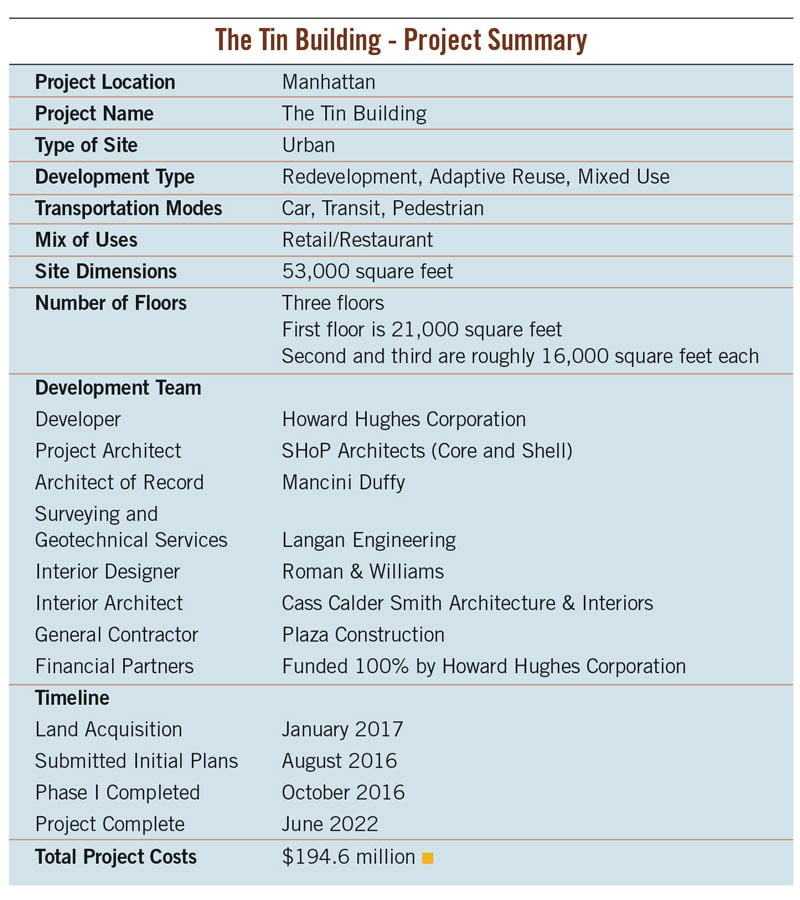The Tin Building: A Fish Market Morphs into a Dining Destination

An adaptive-reuse project in Manhattan rejuvenates a landmark that had fallen upon hard times.
Manhattan’s Tin Building, which has primarily been used as a seafood market, has made several moves during its long life as a commercial building. The Fulton Fishmongers Association first built a wooden market south of the current site along the East River in 1869, then another around the present location near the Brooklyn Bridge in 1894. The current Tin Building was constructed in 1907 and was directly modeled on the 1869 version. In its latest incarnation, it has been reconstructed six feet higher and 32 feet east of that original site.
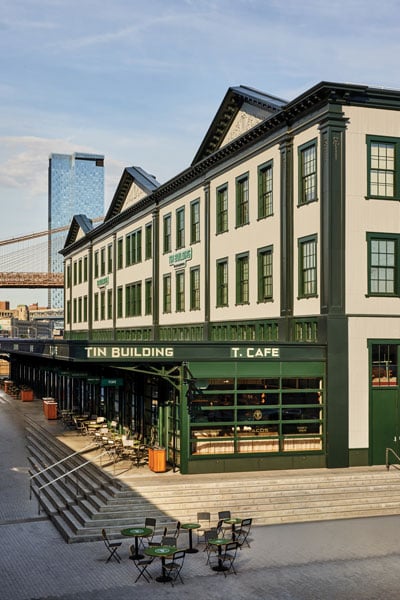
The exterior of the Tin Building with the Brooklyn Bridge visible in the background.
Time was not exactly kind to the structure. There was a massive fire in 1995, and government refrigeration requirements eventually forced the market to move north to the Bronx in 2005, leaving the Tin Building empty and in shambles. Flooding from Hurricane Sandy in 2012 further damaged the facility. However, after nearly a decade of planning and work, it has been transformed into a high-end destination for dining and drink, as well as a consumer-oriented gourmet seafood and grocery market. At 53,000 square feet, it’s the largest enterprise launched by celebrity chef Jean-Georges Vongerichten. It opened in late September, the product of $194.6 million in investment.
The Howard Hughes Corporation, which acquired a 100-year ground lease for the site in 2016, found that it wasn’t merely a case of the building being structurally unstable. Its foundation was as well, as the pier it’s located on had rotted through.
“You couldn’t even walk on the site safely,” said Andrea Teixera, associate principal at SHoP Architects, who worked on the reconstruction of the building.
Additionally, the Tin Building is located within the city’s South Street Seaport Historic District, so the rebuilding effort had to comport with its original form as much as possible.
Getting to Work
The first step when work began in August 2017 was taking the building apart to reconstruct the pier; the next problem was that they couldn’t actually rebuild it on its original plot. Federal Emergency Management Agency (FEMA) flood standards required that the building be raised higher than the 100-year floodplain, which was five feet above its existing height (another foot was added for safety purposes). That sounds simple, but not with FDR Drive located directly above the building’s canopy.
The solution was to move the building 32 feet east, shifting its footprint onto the site of several former storage sheds that were neither useful nor landmarked.
“In an ideal world, we would not move a historical building,” Teixera said. “Unless you could take the FDR out, this is the best you could do.”
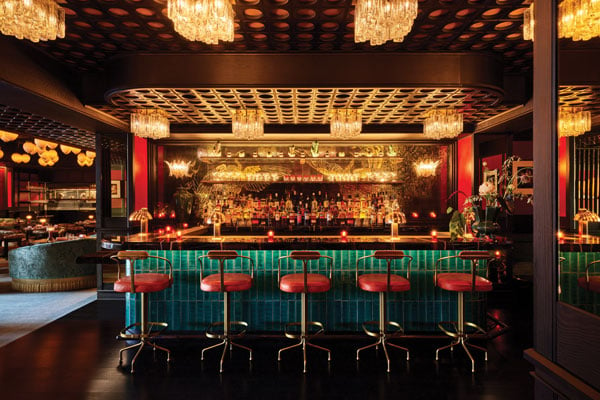
The House of the Red Pearl is a Chinese-themed full-service restaurant.
There were multiple benefits to this relocation. It restored a plaza space in front of the building that had been eliminated when FDR Drive was constructed in 1955, providing the building some breathing room and removing its entrance from the shadow of the elevated freeway. It also enabled SHoP Architects to fill in a missing piece of its East River Waterfront Plan, a multi-stage project that first launched in 2004 with the aim of knitting together the waterfront area from the Financial District through the South Street Seaport to the neighborhoods of the Lower East Side.
The dismantling of the structure revealed that it was in much worse condition than imagined.
“There was barely any usable material in the building,” Teixera said.
This was not a property venerated as historic throughout its life. It was a briny fish market whose maintenance had been minimal. Most of the wood elements were rotten; all metal was rusted to some extent. None of the existing columns could safely support the new building; some could be used to support the canopy and in non-structural functions. Those that were of any possible use were stored in crates, tagged and documented.
The New York Landmarks Preservation Commission, which had to approve all stages of the project relating to its exterior, recommends preserving original elements as much as possible, but sometimes that isn’t viable.
“What you want to do is to preserve the building as much as you can,” Teixera said. “It’s not just the building itself, it’s about preserving the appearance of the building.”
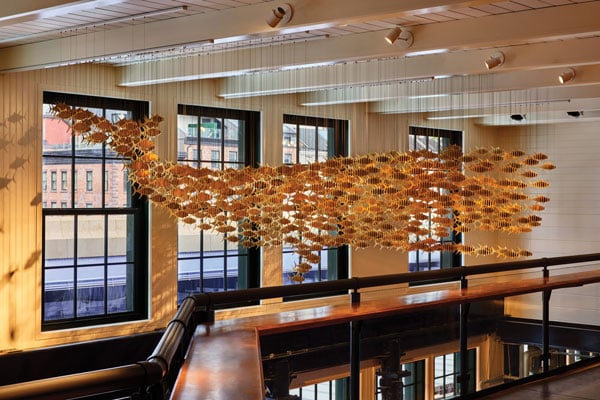
A dramatic installation of a school of fish by artist Michael Murphy hangs from the ceiling.
SHoP placed original cast iron columns at the front of the building and several inside. Other cast iron columns were replicated. Engineering has made quite a few advances since 1907, which enabled a far freer internal structure than the prior column-laden layout, Teixera said.
“The superstructure respected the grid that was in place but worked with bigger spans,” she said.
A close study of the building revealed some odd discoveries. For example, windows on the building weren’t uniformly placed, and some columns weren’t straight (and may never have been).
The building was already unusual; there aren’t many neoclassical corrugated tin buildings, and the undulating surface that lent the building its name was re-created out of painted aluminum. The entablature, cornice, pilasters and canopy brackets were also carefully replicated. Building directly on the water led to material choices that reduced the harm of saltwater exposure. Signage was also modeled closely on historical models. Tongue-and-groove wooden floors and ceilings were re-created.
Inside the building, elements above the ground floor weren’t identified as historic, providing a bit more room for maneuvering.
SHoP also added mechanical systems on top of the building and a limited louvered facade to conceal them. They had considered adding some sort of roof deck atop the structure, but the Landmarks Preservation Commission wouldn’t allow it.
There was another mechanical wrinkle: utilities couldn’t be run through the ground because there is no ground; the building essentially rests on a platform. Everything had to enter horizontally from the shore under the pier and then turn up.
A Piece of the Puzzle
The Howard Hughes Corporation has made a variety of investments in the South Street Seaport district, revamping Pier 17 into a mixed-use complex containing dining, event space, an ESPN studio and a summer concert venue, and it is currently developing a mixed-use residential and office tower at 250 Water Street. The Tin Building was a literal gap between the historic district and Pier 17.
The South Street Seaport has been underutilized in recent decades. Despite being one of the oldest portions of Manhattan and an objectively charming streetscape, for many years it was mainly an underperforming tourist attraction. Saul Scherl, president of the New York tri-state region for the Howard Hughes Corporation, recalled going there in the 1990s.
“There were a lot of ‘I love New York‘ T-shirts and snowglobes, and that even struggled for a while,” he said. “It lost its luster even for tourists.”
That’s been changing in recent years thanks in considerable part to Howard Hughes’ efforts. In addition to Pier 17, other recent arrivals nearby range from a movie theater to offices for fashion designer Alexander Wang, a McNally Jackson bookshop, restauranteur David Chang’s relocated Momofuku Ssäm Bar, and more.
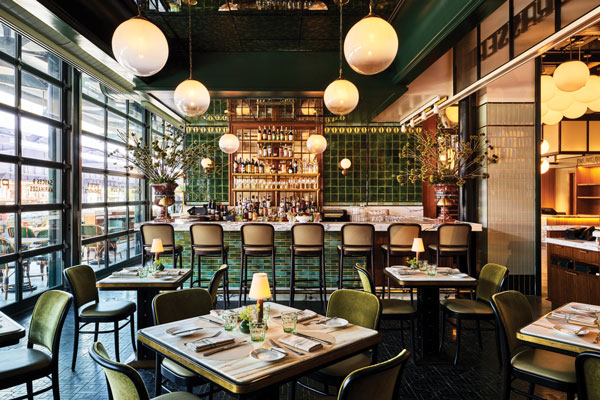
T. Brasserie is a Parisian bistro. It’s one of six casual restaurants, six proper restaurants, four bars and several retailers at the Tin Building.
The Tin Building was a missing piece of the puzzle.
“It’s a historic building but also a connection between the old and new,” Scherl said.
Birth of a Dining Destination
A market hall came to mind quickly as a use. This would not only provide an amenity to the neighborhood and fill a gap, but also echo the historical use of the building.
Vongerichten rapidly became involved, Scherl said.
“We were talking to a lot of different interested parties, and we just had a natural fit with Jean-Georges,” he said. “Frankly, he was the most responsive and the most dynamic in the conversations we had about what we wanted to create there.”
Food halls have become popular and almost commonplace. Scherl and Vongerichten sought to create something that stood out from other offerings in New York. Scherl explained their goal was “to figure out how we can provide something that you don’t see elsewhere in New York.”
Scherl’s aim was to attract any visitors who might be interested, but with a particular eye on the city’s residents.
“For me, it’s about getting New Yorkers back to the seaport,” he said. “How do we make it for New Yorkers as well as for tourists? That’s been the struggle the last seven years, to figure out the programming to make sure we get New Yorkers back.”
Scherl and Vongerichten traveled to Spain, Italy and London to identify elements in market halls that they wanted to replicate in the Tin Building.
They fixed upon an animating concept, which Scherl calls “culinary theater.” The multiple levels feature a pinwheel of design elements. For example, artwork resembling a suspended school of fish, which take the look of either a whale or squid depending on your vantage, sets the tone.
The original plan was to create a market on the first floor and restaurants and bars on the second, but this was changed to distribute a mix of elements on both floors to ensure a steady stream of foot traffic through the entire structure.
“The market is at the core of the whole building,” Scherl said.
The fish counter is the first thing visitors see, and other elements revolve around it. These include six casual restaurants, six proper restaurants, four bars and several retailers.
Knitting Together the Design Elements
Vongerichten had a long history with the old Fulton Fish Market.
“The Fulton Fish Market was one of the first places I visited when I came to New York City in 1986 and has continued to be a consistent part of my New York culinary inspiration ever since,” he said. “It has been surreal to have the opportunity to bring back such an iconic New York staple in a new way while ensuring that we continue the legacy of that one-of-a-kind experience and sense of discovery the market once inspired.”
He also had ideas about how to assemble the space.
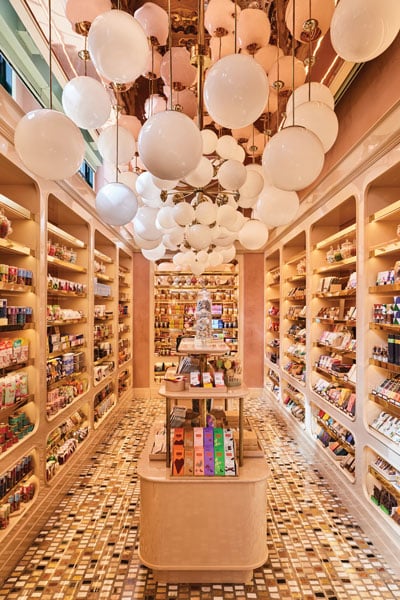
The Spoiled Parrot is a colorful, whimsical candy store.
“Jean-Georges really was critical in figuring out what was going to be next to each other,” Scherl said. “He really thought a lot about that. The beer stand would go in between the taco and the pizza and pasta. That wasn’t chance — it was really thought out. We weren’t going to put the vegan restaurant next to the beer.”
Robin Standefer and Stephen Alesch of Roman and Williams, the interior designers, worked to craft the interior, which is a world away from fish-market drab or the industrial aesthetic that characterizes many recent food halls. The various restaurants and shops are deliberately designed quite differently — but with an eye to larger harmony. Verdigris-tile radius-corner archways demarcate restaurant spaces without walling them off from view. Ceilings are distinctive for numerous spaces. There are exposed ducts and concrete floors but also marble, brass and tamboured wood.
The result is an aesthetic that’s part ferry terminal, part ocean liner lounge. There’s an art nouveau look in French bistro T. Brasserie, charred cedarboard wood in sushi and sake bar Shikku, and Chinosierie wallpaper, velvet banquettes and lanterns in the Chinese-inspired House of the Red Pearl. A candy shop bursts with color or “voltage,” a term Roman and Williams used repeatedly in reference to the project. There’s also The Tasting Studio, a broadcast studio for cooking videos and podcasts that doubles as a dining and reception space.
According to Yvonne Choy, senior associate at Cass Calder Smith Architects, the architect of record on the project, all sorts of practical elements had to be threaded through the building to make this work.
“The interior layout was developed from both the language of the historic Tin Building as well as from a preliminary program provided from the outset,” she said. “Along with Howard Hughes, Jean-Georges and the design teams, each program evolved across the three floors to accommodate operational needs while arranging all the venues to fit and to achieve the best guest experience.”
Figuring out the layout is one task; fitting in necessary support elements is another. “Back of the house” is complicated when there is no back to the house (nor a basement): three sides of the building, including the two longer ones, are public-facing, and the entire third floor is a commissary kitchen.
“The kitchens and the guest-facing spaces are intricately woven together so that the infrastructural elements are out in the open but also out of sight,” Choy said. “The top floor does house the bulk of the kitchen, storage and employee spaces, but there are also eight smaller kitchens on the other two floors that are not visible to the public.”
Some of this juggling is visible and clever; ductwork repeatedly doubles as a canvas for signs.
Scherl noted that there are still challenges, particularly regarding storage space.
“The good thing is we’re on a pier and we’re on the water,” he said. “The bad thing is we have very limited storage. If you go to most of these market halls, you can go into the basement and have all your refrigeration and all your storage down there. Unfortunately. we have no basement.”
Some office space within the building is being studied for possible conversion to storage.
Built for Versatility
Scherl stresses that the Tin Building is intentionally a work in progress.
“There is no final mix,” he said. “The opening mix is changing every day we’re looking at it, and we’re seeing what sells and also what New Yorkers want.”
They’re keen to explore an assortment of seasonal programming that’s designed to comport with other efforts nearby, from ice skating to summer concerts.
The Tin Building’s explicit aim is to accommodate a wide range of diners and shoppers and adapt to seek to keep them all happy.
“People who are coming to experience the market hall are different from people coming to eat at the restaurants,” Scherl said.
Pandemic circumstances helped a bit with this focus.
“In some respects, COVID helped us bring New Yorkers back because tourism wasn’t around, so we had an opportunity to market to New Yorkers and focus on that,” Scherl said.
Scherl noted that the growing residential base of Lower Manhattan was obviously in mind, and that office workers have been a visible presence at lunch and after work. One goal achieved so far is that there is a steady flow of customers at all times, “not just on the beautiful days.”
The ownership team has been active in marketing the Tin Building to New York City by running ads throughout Manhattan, in Brooklyn and in Queens.
On a wall at the Tin Building, a Herman Melville quotation from “Moby-Dick” proclaims “Right and left, the streets take you waterward.” And at this reborn historical market, the options are rather greater than Ishmael’s choice of cod or clam chowder.
Anthony Paletta is a freelance writer based in New York.
